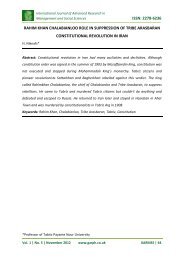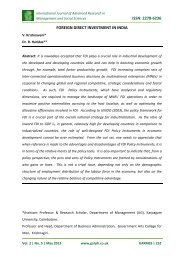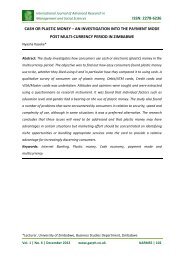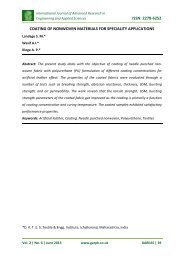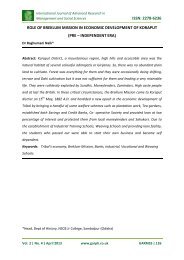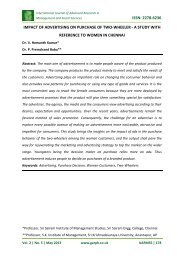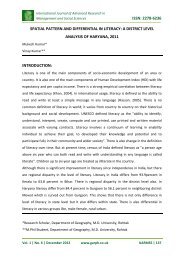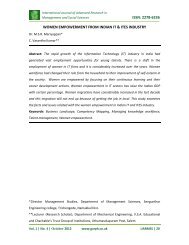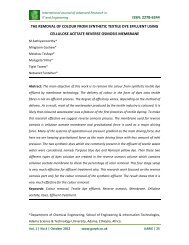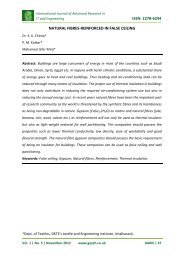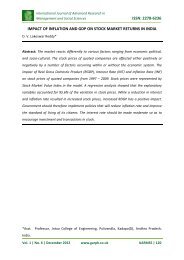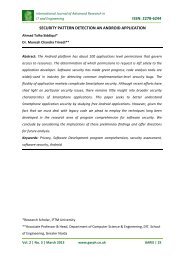issn: 2278-6236 small investor's behaviour on stock ... - Garph.co.uk
issn: 2278-6236 small investor's behaviour on stock ... - Garph.co.uk
issn: 2278-6236 small investor's behaviour on stock ... - Garph.co.uk
You also want an ePaper? Increase the reach of your titles
YUMPU automatically turns print PDFs into web optimized ePapers that Google loves.
Internati<strong>on</strong>al Journal of Advanced Research in<br />
Management and Social Sciences ISSN: <str<strong>on</strong>g>2278</str<strong>on</strong>g>-<str<strong>on</strong>g>6236</str<strong>on</strong>g><br />
INTRODUCTION<br />
The aim of <str<strong>on</strong>g>behaviour</str<strong>on</strong>g>al finance is to analyses the phenomena of market keeping in view the<br />
psychological factors involved in the <str<strong>on</strong>g>behaviour</str<strong>on</strong>g> of investors. Behavioural Finance mainly<br />
focuses <strong>on</strong> how investors interpret and act <strong>on</strong> micro and macro informati<strong>on</strong> to make<br />
investment decisi<strong>on</strong>s. Ac<strong>co</strong>rding to Kent et al. (2001), the most <strong>co</strong>mm<strong>on</strong> <str<strong>on</strong>g>behaviour</str<strong>on</strong>g> that<br />
most investors do when making investment decisi<strong>on</strong> are (1)Investors often do not<br />
participate in all asset and security categories, (2)Individual investors exhibit loss-averse<br />
<str<strong>on</strong>g>behaviour</str<strong>on</strong>g>, (3) Investors use past performance as an indicator of future performance in<br />
<strong>stock</strong> purchase decisi<strong>on</strong>s, (4)Investors trade too aggressively, (5) Investors behave <strong>on</strong> status<br />
quo, (6) Investors do not always form efficient portfolios, (7) Investors behave parallel to<br />
each other, and (8) Investors are influenced by historical high or low trading <strong>stock</strong>s. The<br />
propositi<strong>on</strong> that has dominated finance is Efficient Market Hypothesis (EMH). There are<br />
three basic theoretical arguments that form the basis of the EMH. The first and most<br />
significant is that investors are rati<strong>on</strong>al. Sec<strong>on</strong>dly it is based <strong>on</strong> the idea that every<strong>on</strong>e takes<br />
careful ac<strong>co</strong>unt of all available informati<strong>on</strong> before making investment decisi<strong>on</strong>s. It is related<br />
to internal c<strong>on</strong>sistency. The third principle is that the decisi<strong>on</strong> maker always pursues self-<br />
interest.<br />
The globalizati<strong>on</strong> of financial markets has increased the participati<strong>on</strong> and number of retail<br />
investors’ over the past two decades by providing a wide variety of market and investment<br />
opti<strong>on</strong>s. However, it makes their investment decisi<strong>on</strong>s process more <strong>co</strong>mplex. There are<br />
many investment products which are available for investment to investors in the <strong>stock</strong><br />
market ranging from b<strong>on</strong>ds to opti<strong>on</strong>s. These products vary with regard to risk factor<br />
involved and the return. Investors choose the investment products which have matching to<br />
their risk tolerance. Moreover, investor make up their mind regarding risk factor involved in<br />
any investment based <strong>on</strong> the financial informati<strong>on</strong> they receive from different channels or<br />
sources. Moreover, knowledge of investors regarding financial market and their past<br />
experience c<strong>on</strong>tribute a lot towards the risk assessment in various products. Investors who<br />
have experienced loss in the past formulate new investment decisi<strong>on</strong> having kept in mind<br />
their past experience. These factors al<strong>on</strong>g with some other factors c<strong>on</strong>stitute the risk<br />
aversi<strong>on</strong> and risk percepti<strong>on</strong> of the investors. After formulating risk attitudes the investors<br />
formulate their potential returns from that investment. Low return products are accepted if<br />
Vol. 1 | No. 2 | August 2012 www.garph.<strong>co</strong>.<strong>uk</strong> IJARMSS | 60




